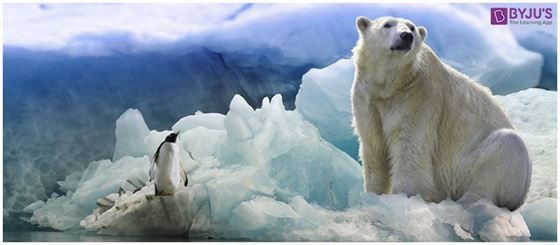As we humans adapt to climatic changes and other weather conditions, other living species also respond and adapt to their environmental conditions.
What is Adaptation?
The term ‘Adaptations’ mainly refers to how a living organism adapts and responds, or how they change their body and behaviour, to better suit the conditions of its natural environment.
There are around 8 to 10 million living species, including plants, animals and birds found all across the world and they have developed themselves to their environments.
For instance: Camels, cacti and other species living in hot desert regions have long adapted to the dry and hot weather. Similarly, the polar bears have adapted to the cold surfaces and thick fur protects them from freezing weather.

Explore more: What is Adaption?
Types of Adaptations
Based on the responses observed in plants and animals, adaptations are further classified into the following types:
- Structural Adaptations
- Behavioural Adaptations
- Physical Adaptations
Structural Adaptations
This type of adaptation is mainly based on unique attributes which involve body parts, such as the shape of the body, texture and colour of the skin, etc. This type of adaptation helps organisms to survive in their natural habitat.
Camouflage is one of the common structural adaptations seen in animals.
Examples of structural adaptations include:
- Baleen is a filter-feeding system present inside the mouth of the whales, which functions as a sieve by filtering krill and other smaller fishes for their food.
- A woodpecker bird has a sharp and pointed beak, which helps in making their nests in tree trunks and finding insects for their food.
Behavioural Adaptations
Animals and birds usually practise this type of adaptation to survive in their environments.
Dormancy, camouflage, hibernation and migration are different types of behavioural adaptations practised by both plants and animals.
Examples of behavioural adaptations include:
- Bears, bats, bumblebees, honey bees and other species hibernate in winter to escape the cold temperatures and preserve food and energy.
- Some species of birds and animals migrate to different places in search of food and shelter.
- Some plants exhibit dormancy when growth and other developments are temporarily stopped due to unfavourable environmental factors. Seed dormancy is an example of a plant showing behavioural adaptations. This type of adaptation is seen both in plants and animals.
Also Refer: Flight adaptation in Birds.
Let’s look more in detail about Physiological Adaptations.
What are Physiological Adaptations?
This type of adaptation is present in all living organisms, including humans, birds, animals and plants. As per its name, physiological adaptation refers to the internal organs, tissues and cells. In this type of adaptation, the cellular features, internal organs, changes in the hormonal level, mood swings and other features help an organism to survive, adapt and respond to the changes in its environment.
There are many examples of physiological adaptation. Some have been discussed below:
- Venomous animals produce poison to catch their prey, to protect themselves or to ward off predators.
- The thick skin and fur help and protect animals from extreme cold and prevent heat loss from their body.
- During hibernation, animals remain without food and water. This is possible, as their cells help them by storing energy. In some animals, the wastes and other excretory products are stored within their bodies for longer periods of time, without poisoning themselves or causing harm to other organs.
- Animals like camels and other desert habitats have well developed cellular systems. They function by storing enough water and preventing cells from swelling when they drink loads of water. They shrink and thicken the cells during dehydration in animals.
- Apart from animals, this type of adaptation is also observed in some species of plants. Plants of deserts and drylands, where water is scarce, have physiologically adapted to their environments. The roots, stems and other parts of plants have a well-developed storage system that stores water for a more extended time and prevents dehydration. For example, cactus.

Even in humans, physiological adaptation can be observed and is called human adaptation.
Also Refer: Adaptation And Habitats
This article concludes with an introduction to adaptations and physiological adaptations.
Stay tuned to BYJU’S Biology to learn more about adaptations, different types of adaptations in plants and animals, human adaptation, important questions and other related topics.
Comments